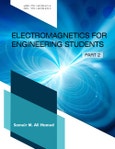Electromagnetics for Engineering Students starts with an introduction to vector analysis and progressive chapters provide readers with information about dielectric materials, electrostatic and magnetostatic fields, as well as wave propagation in different situations. Each chapter is supported by many illustrative examples and solved problems which serve to explain the principles of the topics and enhance the knowledge of students. In addition to the coverage of classical topics in electromagnetics, the book explains advanced concepts and topics such as the application of multi-pole expansion for scalar and vector potentials, boundary-value problems in cylindrical and spherical coordinate systems, metamaterials, artificial magnetic conductors, the concept of negative refractive index, and the detailed analysis of circular waveguides.
Key features of this textbook include:
- detailed and easy-to follow presentation of mathematical analyses and problems
- a total of 681 problems (162 illustrative examples, 88 solved problems, and 431 end of chapter problems)
- an appendix of mathematical formulae and functions
- Electromagnetics for Engineering Students is an ideal textbook for undergraduate engineering students who are learning about electromagnetics and related mathematical theorems.
Table of Contents
1. Foreword
2. Preface
3. Propagation of Uniform Plane Waves
4. Reflection, Transmission, and Negative Refraction
5. Rectangular Waveguides
6. Circular Waveguides
7. Resonant Cavities
8. Transmission Lines
9. Principles of Antennas
10. Appendix A: Bessel Functions
11. Appendix B: Associated Legendre Functions
12. Appendix C: Useful Integrals and Mathematical Formulas
13. Appendix D: Frequency Bands
14. Appendix E: Physical Constants
15. References
16. Subject Index
Author
Sameir M. Ali Hamed








